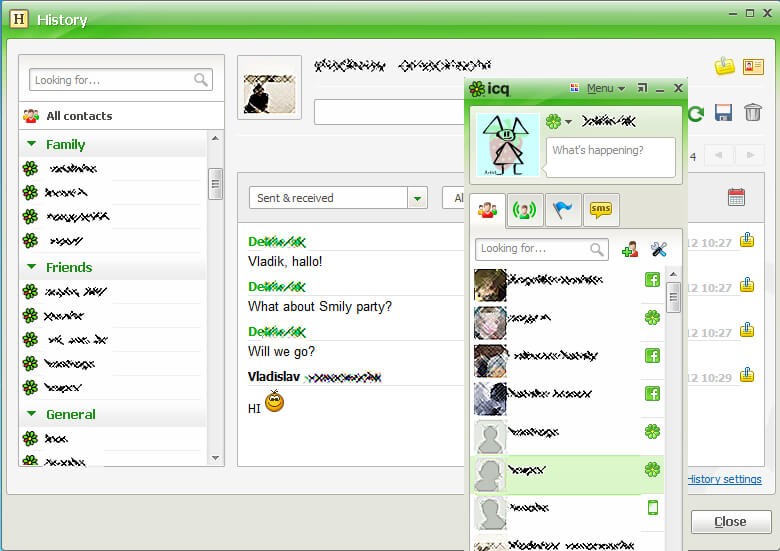Insight Blog
Agility’s perspectives on transforming the employee's experience throughout remote transformation using connected enterprise tools.
11 minutes reading time
(2216 words)
Instant Messaging at Work: Why do employees use instant messaging?
In this article, we explore Why do employees use instant messaging and delve into the historical background of this form of communication. and, we examine the benefits it brings to organizations within the workplace.
In this article, we explore Why do employees use instant messaging and delve into the historical background of this form of communication. and, we examine the benefits it brings to organizations within the workplace.
In the modern workplace, effective communication is crucial for success. Among various communication tools, instant messaging has emerged as one of the most effective software solutions for office communication.
It has gained widespread popularity not only in personal life but also in the corporate world. Instant messaging platforms not only complement traditional modes of communication but also have the ability to replace certain forms of communication altogether.
Instant messaging provides several advantages.
Firstly, it offers near-instantaneous communication similar to telephone conversations, allowing for real-time exchanges of information.
Additionally, instant messaging platforms incorporate record-keeping features akin to email messaging, ensuring that conversations can be referred back to later if needed.
While face-to-face interactions and meetings remain valuable, instant messaging enhances convenience and accessibility by enabling communication regardless of distance, whether your colleagues are sitting at the next desk or in another country.
What is instant messaging?
Instant messaging, often abbreviated as IM or IM'ing, refers to the exchange of near-real-time messages using a standalone application or embedded software. Unlike chatrooms where multiple users engage in overlapping conversations, IM sessions typically occur between two users, allowing for private and interactive communication.
A key feature found in many instant messenger clients is the ability to determine if a friend or colleague is online and connected to the selected service, which is known as presence.
With advancements in technology, IM clients have incorporated additional functionalities like file transfer and image sharing within an ongoing IM session.
The immediacy of message exchange sets instant messaging apart from email. IM conversations are session-based, meaning they have a clear start and end.
As IM aims to replicate face-to-face discussions, individual messages tend to be concise.
Conversely, email often adopts a more extended format resembling letter writing.
The history of instant messaging
Now let's delve into the history of instant messaging.
The concept of instant messaging originated in the 1960s and 1970s with the development of multi-user operating systems and online chat programs.
However, the true rise of instant messaging began in the 1990s with the advent of the internet and the growth of personal computers. The first widely-used instant messaging platforms emerged during this time, including ICQ, AOL Instant Messenger (AIM), and MSN Messenger.
As technology advanced, so did instant messaging. The introduction of smartphones and mobile internet in the early 2000s led to the proliferation of mobile instant messaging applications such as BlackBerry Messenger (BBM) and WhatsApp.
These apps allowed users to stay connected and exchange messages on the go.
Today, instant messaging has become an integral part of both personal and professional communication. Workplace communication platforms like Slack, Microsoft Teams, and Google Chat offer advanced instant messaging features specifically tailored for organizational use.
These platforms often include additional functionalities such as file sharing, video calls, and integration with other workplace tools, further enhancing productivity and collaboration.
Why do employees use instant messaging?
Employees use instant messaging for several reasons, and its importance as a feature within an intranet or employee communication software cannot be overstated. Instant messaging provides employees with a convenient and efficient means of communication, allowing them to exchange messages and information in real-time.
One of the primary reasons employees use instant messaging is for quick and informal communication. Unlike email, which can be seen as more formal and time-consuming, instant messaging allows for immediate and brief interactions.
It enables employees to ask questions, seek clarifications, or share updates without the need for lengthy email exchanges or scheduling meetings. This speed and convenience foster better collaboration and decision-making within teams.
Another reason employees value instant messaging is its ability to support remote work and facilitate virtual collaboration. With the rise of remote and distributed teams, instant messaging provides a way for employees to stay connected regardless of their physical location.
It enables real-time communication, ensuring that remote workers feel connected and can participate actively in team discussions. Instant messaging also helps foster a sense of camaraderie and social interaction, which can be lacking in remote work environments.
Also, instant messaging offers a platform for sharing files and documents, further enhancing productivity and collaboration. Employees can quickly send and receive files, eliminating the need for cumbersome email attachments.
This feature promotes seamless information sharing, allowing teams to work together more efficiently and effectively.
It enables quick and informal communication, facilitates virtual collaboration, and streamlines the sharing of files and documents.
By incorporating instant messaging into their communication platforms, organizations can enhance employee productivity, foster teamwork, and create a more connected and engaged workforce.
An intranet portal or employee communication app with a messaging platform offers employees the ability to personalize their profiles, streamline self-service procedures like leave applications, and simplify the onboarding process for new staff members.
Additionally, it allows for the creation of exclusive extranet portals, enabling external users to engage with the company without requiring access to the primary local network. This functionality provides a range of benefits to organizations.
Why use instant messaging?
Instant messaging, often abbreviated as IM or IM'ing, refers to the exchange of near-real-time messages using a standalone application or embedded software.
Unlike chatrooms where multiple users engage in overlapping conversations, IM sessions typically occur between two users, allowing for private and interactive communication.
A key feature found in many instant messenger clients is the ability to determine if a friend or colleague is online and connected to the selected service, which is known as presence.
With advancements in technology, IM clients have incorporated additional functionalities like file transfer and image sharing within an ongoing IM session.
The immediacy of message exchange sets instant messaging apart from email. IM conversations are session-based, meaning they have a clear start and end. As IM aims to replicate face-to-face discussions, individual messages tend to be concise.
Conversely, email often adopts a more extended format resembling letter writing.
Instant messaging in the workplace
- Real-time communication - Instant messaging allows for quick and immediate communication between colleagues, facilitating instant responses and enabling faster decision-making processes.
- Efficient collaboration - Instant messaging platforms provide a convenient way for team members to collaborate on projects, share ideas, and exchange information in real-time. It promotes seamless collaboration and helps teams stay aligned and productive.
- Remote work facilitation - In an increasingly remote work environment, instant messaging bridges the geographical gap by keeping remote employees connected. It enables virtual teams to communicate effectively, irrespective of their physical locations, fostering collaboration and teamwork.
- Informal and quick interactions - Instant messaging offers a more casual and informal communication channel compared to formal emails or phone calls. It allows for quick questions, updates, or clarifications, reducing the need for lengthy conversations or formal meetings.
- Multi-device accessibility - Instant messaging can be accessed from various devices such as computers, smartphones, and tablets, ensuring that employees can stay connected and engaged even while on the move or away from their desks.
- Presence indication - Many instant messaging platforms include a presence feature that indicates whether a colleague is online, busy, or available. This helps in determining the best time to reach out and promotes efficient communication.
- Document and file sharing - Instant messaging often incorporates file-sharing capabilities, allowing employees to quickly exchange documents, presentations, and other files within the chat interface. This promotes seamless collaboration and avoids the need for separate email attachments.
- Team bonding and social interaction - Instant messaging platforms often have features that encourage social interactions among colleagues, such as group chats or channels dedicated to non-work-related discussions. This helps foster a sense of camaraderie and team bonding, even in virtual work environments.
Follow us and access great exclusive content everyday: Follow us on Google News
Implementing instant messaging in the workplace
Implementing instant messaging in the workplace involves several key steps to ensure a successful integration:
- Assess organizational needs - Begin by evaluating the specific communication needs of your organization. Identify the pain points, areas where instant messaging can enhance collaboration, and the desired outcomes of implementing such a system.
- Choose a suitable platform - Research and select an instant messaging platform that aligns with your organization's requirements. Consider factors such as security, ease of use, integration with existing systems, mobile accessibility, and features like file sharing and presence indication.
- Plan for deployment - Create a deployment plan that outlines the implementation process, including timelines, milestones, and any necessary training or onboarding activities. Consider how you will introduce the new tool to employees and address any potential resistance or concerns.
- Set guidelines and policies - Establish clear guidelines and policies regarding the use of instant messaging in the workplace. Define acceptable use, privacy measures, data protection, and guidelines for appropriate communication. Communicate these guidelines to all employees to ensure consistent and responsible usage.
- Train and educate employees - Provide comprehensive training on how to use the instant messaging platform effectively. Offer tutorials, resources, and hands-on sessions to familiarize employees with the features and functionalities. Highlight best practices for communication etiquette, security measures, and efficient collaboration.
- Encourage adoption and engagement - Foster a culture of adoption and encourage employees to embrace instant messaging as a valuable communication tool. Highlight the benefits it brings, such as faster collaboration, improved efficiency, and streamlined communication. Encourage employees to use the platform, share success stories, and address any concerns or challenges they may encounter.
- Monitor and evaluate - Continuously monitor the usage and effectiveness of the instant messaging system. Gather feedback from employees and assess whether the implementation is meeting the intended goals. Make necessary adjustments and improvements based on feedback to ensure ongoing success.
- Ensure security and compliance - Implement security measures to protect sensitive data and ensure compliance with relevant regulations. Encourage employees to adhere to data protection guidelines and regularly update the instant messaging platform to address any security vulnerabilities.
- Integrate with other tools - Explore opportunities to integrate the instant messaging platform with other productivity tools or systems used within the organization. Seamless integration can enhance workflow efficiency and simplify communication processes.
- Evolve and adapt - Stay updated with new features, updates, and advancements in instant messaging technology. Continually assess the evolving needs of your organization and make adjustments to the implementation strategy as required to optimize the benefits of instant messaging in the workplace.
Instant messaging workplace policy
The purpose of this policy is to establish guidelines and expectations regarding the use of instant messaging (IM) in the workplace.
This policy aims to ensure efficient and responsible use of IM, promoting effective communication while maintaining security and privacy.
Policy:
- Acceptable Use - a. Instant messaging should be used for work-related purposes and professional communication. b. Employees should exercise discretion and avoid engaging in personal or non-work-related conversations during working hours.
- Security and Confidentiality - a. Employees must not share sensitive or confidential information through instant messaging unless it is encrypted and authorized. b. All employees are responsible for safeguarding their login credentials and ensuring that their IM accounts are not accessed by unauthorized individuals.
- Professional Conduct - a. All communication conducted through instant messaging should adhere to the same professional standards as other forms of workplace communication. b. Employees should refrain from using offensive, discriminatory, or inappropriate language or content in IM conversations.
- Data Protection - a. Employees must not download or share unauthorized software, files, or documents through instant messaging. b. All data shared through instant messaging should comply with relevant data protection and privacy regulations.
- Respect for Others - a. Employees should respect the availability status of their colleagues and avoid sending instant messages during designated "busy" or "do not disturb" periods. b. Instant messaging should not be used to disrupt or harass colleagues.
- Reporting Misuse or Security Concerns - a. Employees should promptly report any instances of misuse, inappropriate behavior, or security concerns related to instant messaging to the appropriate authority. b. Whistleblower protections will be in place for employees reporting any violations or breaches of this policy.
- Monitoring - a. The organization reserves the right to monitor and review instant messaging activities for security, compliance, and legal purposes. b. Monitoring activities will be conducted in accordance with applicable laws and regulations.
Consequences of Policy Violations: Violation of this instant messaging workplace policy may result in disciplinary actions, up to and including verbal or written warnings, suspension, termination, or legal consequences, depending on the severity and frequency of the violation.
This policy will be reviewed periodically to ensure its relevance and effectiveness. Updates may be made as necessary to address emerging technologies, changing business needs, or regulatory requirements.
By adhering to this policy, employees contribute to a productive, respectful, and secure workplace environment where instant messaging serves as an effective communication tool for work-related purposes.
You may also like: Best Apps for Employees: UPDATED 2022 – A Complete Guide
Free ebook: How To Get Your Intranet Off The Ground
Categories
Blog
(2638)
Business Management
(325)
Employee Engagement
(212)
Digital Transformation
(176)
Growth
(120)
Intranets
(119)
Remote Work
(61)
Sales
(48)
Collaboration
(37)
Culture
(29)
Project management
(29)
Customer Experience
(26)
Knowledge Management
(21)
Leadership
(20)
Comparisons
(6)
News
(1)
Ready to learn more? 👍
One platform to optimize, manage and track all of your teams. Your new digital workplace is a click away. 🚀
Free for 14 days, no credit card required.
















